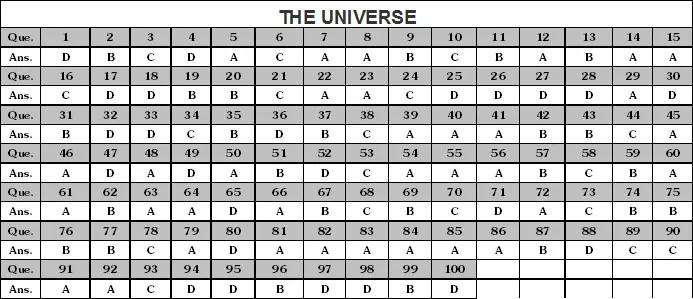INTRODUCTION
The universe is a huge space which contains everything that exists. 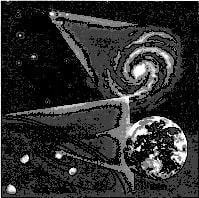 The vast expanse of space that contains everything in it is known as the universe. It
The vast expanse of space that contains everything in it is known as the universe. It
includes the sun, the planets, the Milky Way galaxy and all the other galaxies. The universe is continually expanding. Nobody knows how big the universe is.
It is impossible to even have shown that the universe is getting bigger and bigger, like a balloon being blown up. The branch of science that deals with the study
of heavenly bodies is called astronomy. People who study the universe are called astronomers. The most important
instrument used by the astronomers is the telescope.
* FACT FILE
NIGHT SKY
During the daytime you can see only the sun, which appears to move from East to West.
After sunset, the night sky is dotted with bright stars. At night the moon and thousands of stars are seen twinkling in the sky. If you watch the sky through a telescope you may see
millions of stars, some of which are brightly coloured. You see certain groups of stars which appear to be forming figures in clusters. They are called constellations. The moon is
a natural satellite of earth whose size changes every day. Moon completes one revolution around the earth in 27 days, 7 hours and 43 minutes.
Furthermore, you see an occasional comet, which appears as a ball of fire, having a tail. Then, there are shooting stars or meteors. They appear to fall from the sky. In
addition to all these there are some bright heavenly bodies which do not twinkle. They are called planets.
The natural bodies in the sky are called celestial bodies or heavenly bodies. Example– The sun, the earth, the moon, planets, stars, meteors, comets are called heavenly
bodies or celestial bodies.
THEORIES OF THE ORIGIN OF UNIVERSE
The three main theories are :-
(1) Big-Bang theory :- According to this theory the universe was born after a massive explosion called the Big-Bang. A long time after the Big-Bang, stars like our sun were formed.
At that time clouds of hot gases and particles revolved around the sun. Over time, many particles got stuck together to form large bodies. The bodies pulled in smaller objects near them by
gravitational force. "This made them larger still. These bodies finally become the planets and this universe has been expanding ever since".
(2) Steady state Theory :- This theory states that the universe appears the same at all times and at all points. It is unchanging without a beginning or an end.
(3) Pulsating Theory :- This theory states that all matter is flying apart from a heavily compacted mass and will eventually slow down, begin to contract and become so condensed that it
will explode again and the expansion will start again.
MEASUREMENT OF DISTANCES IN THE UNIVERSE
The distances between heavenly bodies in space are very large. It is very difficult to measure these distances in kilometre. That is why, they are expressed in terms of light year and parsec.
(a) Light Year: A light year is the distance travelled by the light at a speed of 300,000 km/s.
If a spaceship could travel at the speed of light (3 x 105 km/s), it would reach the moon in just over 1 second.
1 light year = Speed of light × 365 days = 3,00,000 km/s × 365 × 24 × 60 × 60 sec.
= 9,460,000, 000, 000 km
1 light year = 9.46 × 1012 km (approx.) The sun, the closest star to earth, is about 8 light minutes away from it. It means that light from sun takes about 8 minutes to reach the Earth.
The star closest to the Earth after the Sun is Alpha Centauri It is 4.3 light years away from Earth, i.e., it is at a distance of 4.3 × 9.46 × 1012 km from Earth. It also implies that
light from this star, visible on Earth, at a particular night would have left its surface approximately 4.3 years ago.
(b) Parsec: One Parsec (pc) is equal to 3.26 light years. The distance of Proxima Centauri which is a companion of, Alpha Centauri' is 1.3 parsec
STAR
Stars are heavenly bodies that are extremely hot and give out light of their own. Stars are mainly made up of hydrogen. Inside the stars hydrogen is continuously
being converted into helium by fusion reaction and this releases a tremendous amount of energy which is given out as heat and light. Stars vary in colour depending on their temperatures.
(a) Stars twinkle because we look up at the stars through air that is constantly blowing about, so we receive their light as unsteady and thus they seem to twinkle.
(b) The stars appear to us like points, because they are very far away from the earth.
(c) Stars appear to move from east to west because the earth rotates about its north-south axis from west to east. Thus, due to relative motion, all heavenly bodies
(stars, planets, moon) appear to move from east to west.
(d) The pole star (polaris or Dhruva Tara) not change its position in the sky because it is situated in the direction which is directly above the geographic north-pole of
the earth’s axis. Thus, its position relative to the earth does not change and hence, it appears stationary.
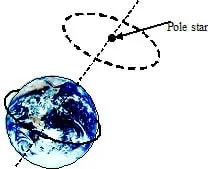
(e) The start nearest to the earth is the sun itself & light from sun reaches to us in 8.3 light minutes.
The next nearest star is the Alpha Centaury or Proxima Centaury & it is at a distance of 4.3 light years.

GALAXIES
A galaxy is an assemblage of billions of stars together with gas and dust which are bound to one another by gravitational forces.
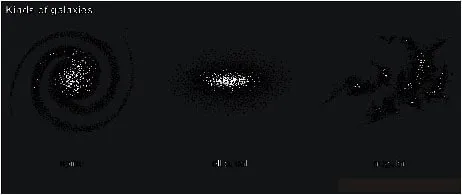
TYPES OF GALAXIES:-
(1) Spiral galaxy :-
A spiral galaxy is a flattish disc with a large bulge at the centre. The central region is very bright. Spiral arms coil outwards directly from the bulge.
Our sun is a part of spiral galaxy called the milky way galaxy. This galaxy is named after the milky way. The milky way is a band of stars that we can see on a clear night.
Our milky way galaxy (Akash ganga) and another one andromeda galaxy are examples.
(2) Elliptical galaxy :-
An elliptical galaxy is like a spiral galaxy without arms. Example : M 87
(3) Irregular galaxies :-
These galaxies do not have specific shape.
Example : The large and small magellanic clouds.
CONSTELLATIONS
In the sky, some stars appear in distinct group consisting of a few stars arranged in such a way so as to form different shapes.
A group of such stars whose arrangement can be compared with different shapes is called a constellation. You can easily identify some constellations even with the naked eye.
Some constellations are discussed below:
1.Ursa Major (Vrihat Saptarishi)
Ursa Major contains seven bright stars arranged in the pattern resembling some what a big spoon. Ursa Major is also given the name Big Dipper. This name is derived
from the word 'dipper' which in olden days meant a large spoon used for drinking water. Ursa Major is also known as the Great Bear because along several other faint stars,
it forms the shape of a bear.
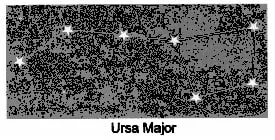
In the group of stars in Ursa Major, seven are comparatively . brighter and are easily visible in northern part of sky in the months from April to September.
Pole star can also be located with the help of Ursa Major. Pole star is visible towards the north and remains stationary in the sky with respect to the earth.
A straight line drawn through the two stars at the top (called pointers) of Ursa Major passes through the pole star. The Pole Star· was used by sailors to find the north direction.
The Indian name of Ursa Major constellation is Saptarishi Mandal.
2. Ursa Minor (Laghu Saptarishi)
Ursa Minor or Small Dipper also contains seven prominent stars in it. It is also one of the easily identifiable constellations. The stars in Ursa Minor are smaller
as compared to Ursa Major. This constellation is an outline of a small bear or ladle of a kite with long tailor a question mark at the tail of Ursa Minors is a star of average brightness.
It is called: Pole star and the Indian name of Pole star is Dhruv Tara. Pole star appears stationary in the sky and all other constellations appear to revolve around it.
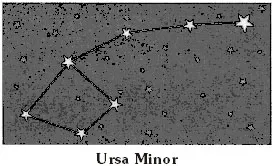
The Indian name of Ursa Minor constellation is Laghu Saptarishi. It can be seen in July during summer.
3.Orion (Mriga)
Orion or Hunter is another constellation which is visible during winter season. It looks like a hunter and is one of the most magnificent constellations in the sky. It
has seven bright stars and several faint ones. Four bright stars make the shoulders and legs of the hunter and these stars mark its belt. Some faint stars complete the picture.
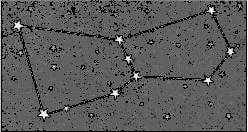
Orion constellation
One of the largest star known as Betelgeuse and another bright star called Rigel are situated at its two corners.
The Indian name of Orion constellation is Vyadha or Mriga.
4. Scorpio (Vrishchika)
This constellation contains seven bright stars. Along with other faint stars, it forms the shape of a scorpion It is visible during winter months. The Indian name
of Scorpio constellation is Vrishchika.
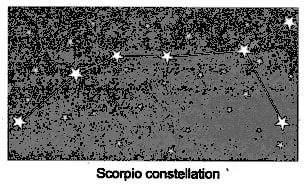
Scorpio constellation
5.Cassiopeia (Sharmishtha)
This constellation is a group of five stars arranged in the form of W. It is seen near pole star and is visible in the month of October in northern sky.
The Indian name of Cassiopeia constellation is Sharmishtha.
6.Pleiades (Kruttika)
The stars in this constellation do not have any particular arrangement. It looks like a cluster of stars and twinkling gems in the night sky. The cluster of
stars in this constellation are called globular clusters. It is visible in winter months. The Indian name of Pleiades constellation is Kruttika.
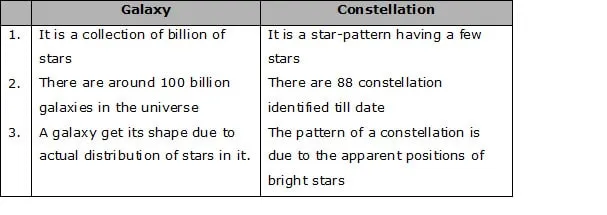
THE SOLAR SYSTEM
"The sun and all the bodies moving around it are together called the Solar System".
The solar system consists of the sun, the eight planets, moon, comets and asteroids which revolve around the sun in almost circular paths or orbits.
1.THE SUN
The closest star to the Earth is Sun. The average distance of the sun from the Earth is 150 million kilometre which is about 110 times the diameter of the Earth. 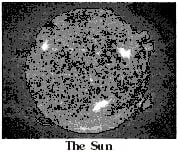
The temperature at its centre is about 14 million degree Celsius; while its surface temperature is about 6000°C the temperature of Sun is very high because of very hot gases present in it. Hydrogen and helium are the gases which produce heat and light in the
sun.
The sun is the brightest object in the sky. It is about 333000 times heavier than the earth and you could fit more than a million earth inside it. Its great mass cause a large gravitational force.
This keep the sun and planets. The moons and some other smaller bodies together are as the sun family.
2.PLALETS
The solar system is the set of eight planets including Earth. All the planets move around the sun in elliptical orbits. At the same time they spin or rotate on their own axis
within the solar system.
Each planet takes different time to complete one revolution around the sun. Earth takes about 365¼ days. Mercury which is closest to the Sun takes only 88 days to
complete one revolution.
Beside revolving around the sun in 365¼ days, the Earth also rotates about its axis once every 24 hours. Other planets also rotate on their axes. The period of rotation is least for
Jupiter, only 9 hours 55 minutes and the maximum for Venus which is 243 earth days.
The planets are bright objects visible at night looking like stars. Some of them on being seen carefully, seem to be brighter and bigger than the stars. Some of the planets are
known from ancient times while some were discovered only after telescope became available to observe the night sky.
After the sun planets are the largest bodies in our solar system. Scientists define a planet as a round body that orbits the sun and which has pulled in all objects near its orbit.
Planets were formed when large bodies in space pulled in smaller bodies near it.
There are eight planets in the solar system. In order of their distance from Sun, they are described below:
(1) Mercury (2) Venus (3) Earth (4) Mars (5) Jupiter (6) Saturn (7) Uranus and (8) Neptune
(i) Mercury (Budh) : It is the first and the nearest planet to the 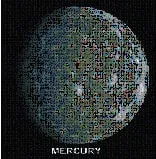
Sun. Being very close to the Sun, Mercury is very hot during the day (about 400°C) and extremely cold at night (about -200°C). It has no atmosphere
because of its gravitational force. Mercury is covered with many bowl shaped holes called craters. Mercury is occasionally visible just before the sunrise
or immediately after the sunset. It appears likes a very bright star and is also known as the morning or evening star. Although
it is not a star it is called morning or evening star because of its brightness.
Mercury also resembles moon in many ways. Both are nearly of the same
size and mass. Both have no atmosphere and their surfaces are rocky too.
(ii) Venus (Shukra) : 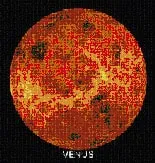
It is the second planet from the sun and its closest planet is the Earth. Venus is of about the same size as the Earth. It is a very hot planet (about 480°C), even hotter than Mercury. Though it is farther away from the sun, it appears to be brightest of all planets, moon and stars,
visible in the night sky. It is due to its cloudy atmosphere that is reflects
almost 3/4 of the sunlight that falls on it. It occasionally appears as an evening star just above the western horizon. It sometimes also appears as morning star in the eastern sky. As it is closer to the sun it is not visible throughout the year.
(iii) Earth (Prithvi) : 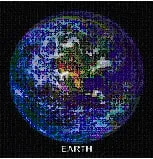
It is the third planet from the sun. The Earth is the only planet to
have life on it. All the factors supporting life are know to be present on Earth
only. The average diameter of Earth is about 12,800 kilometre.
The Earth as you know, revolves around the sun in 365.25 days known as one
Year. It also rotates about an imaginary axis that passes through its North and
south poles. This rotation causes day and night on the earth.
The change in seasons on the earth takes place due to the tilting of its axis
of rotation and the change in its position with respect to the sun. It is tilted
at an angle of 23½ ° .
As the tilting is always in the same direction therefore the tilting of the northern and southern hemisphere of the earth towards the sun keeps changing
throughout the year. Figure given above shows the change of seasons on four dates 21 March, 21 June, 23 September and 21/22 December.
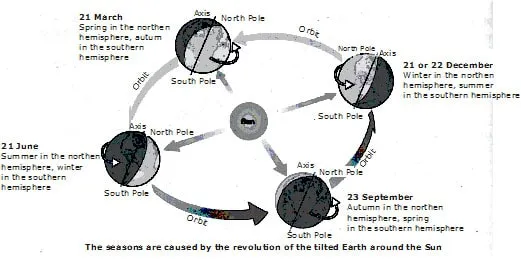
(iv) Mars (Mangal) : 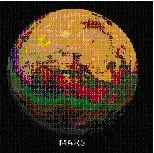
It is the fourth planet in the order of increasing distance from the sun. It is seen as a reddish coloured object in the sky, hence it is sometimes also
called the red planet. It is believed that Mars has a large amount of water in the form of ice, near its polar caps. The diameter of Mars is slightly more
than half of that of the earth but its mass is only one tenth of that of the earth. It is believed to have lots of carbon dioxide on it. Astronomers are
investigating the fact that it may have water and also it may have life in some form. It has a thin atmosphere which enables to view its
surface from the earth.
(v) Jupiter (Brihaspati) : 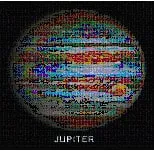
It is the fifth planet from the sun. It is the largest planet of the solar system. It is so large that about 1300 Earths can be placed inside this planet. It has
a large red spot on its surface. This spot is actually a giant storm. Its distance from Sun is more than the sum of distances of first four planets from the Sun.
For this reason, it gets less light and heat of the Sun. Yet it appears brighter than almost all other planets due to thick atmosphere surrounding it. It has a
faint ring around it. It can be observed as a very bright object for about half the year in the evening sky.
Jupiter has 28 moons.
Jupiter has the shortest day (of a hours 55 minutes) among all the planets.
Jupiter's moon Ganymede is the largest moon in the Solar System, and is larger than the planet mercury.
(vi) Saturn (Shani) : 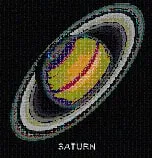
It is the sixth planet from the sun. Its distance from sun is almost double the distance of Jupiter from the sun. Its size, mass and composition is similar
to Jupiter but it is colder than Jupiter. It has three beautiful flat rings encircling in which are made of particles possibly consisting of ice. These rings are
not visible by the naked eye but can be observed with the help of a telescope. Saturn rotates about the axis in 0.44 days and completes its revolution around
the sun in 29.5 years. Due to very low
temperature, life is not possible on Saturn.
(vii) Uranus (ARUN) : 
It is the seventh planet from the sun. It was discovered by an English astronomer, William Herschel, in 1781. Uranus is a large planet and is very far away
from the sun and the Earth. It appears green when seen
through a telescope. It is a very cold planet and thus cannot sustain life.
(viii) Neptune (VARUN) : 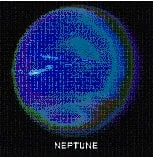
It is the eighth planet from the Sun. After Uranus, this was the second planet to be discovered with the help of a telescope. It was discovered by Urbain Jean Joseph Liverier a French astronomer in 1846. His predictions and later discovery of Neptune were based on' the . changes
observed in the path of Uranus from its orbit.
3. ASTERIODS
These are very small planets or planetoids that are found mainly in a belt between the orbit of mars and Jupiter. Each asteroid has its own orbit and the orbits
of all of them are spread over a large distance, forming a band. Astronomers have discovered more than 500 asteroids which are larger than 48km in diameter. Ceres
is the largest of the asteroids discovered till now.
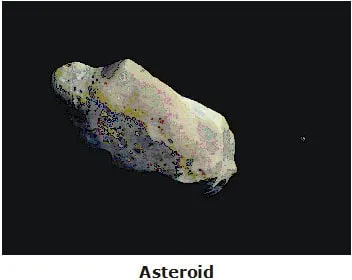
4. COMETS
Comets are very small sized celestial bodies which revolve around the sun in highly elliptical orbits. Comets appear like a ball of fire with a long tail. The
length of the tail of a comet increases while coming towards the sun. It disappears again when "comet moves away from the sun. The tail of comet always
points away from the sun because of pressure of solar radiations.
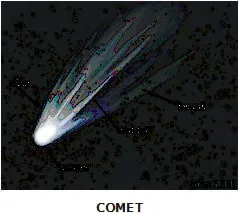
Out of the many comets appearing again and again, one of the most famous comet is Halley's comet. It is usually visible in the night sky once in 76 Years. Halley's
comet was last seen in 1986. It is believed to appear again in 2062.
5. METEOR AND METEORITES
Meteors are very small stone like objects revolving around the sun. These are bright star like objects which appear suddenly in the sky and then for a few moment
glow with a brilliant white flash of light falling towards the earth. Although they are not stars but they are called shooting stars as they glow like a star. While falling
on the earth these stone like objects when enter into the atmosphere of earth, get heated due to friction of air, they get so much heated that they first glow brightly and
start evaporating. Hence They sky momentarily.
Some meteors are so large that they do not get completely burnt and evaporated. Then a part of them reaches the surface of the earth. These unburnt part of the meteors
are called meteorites.
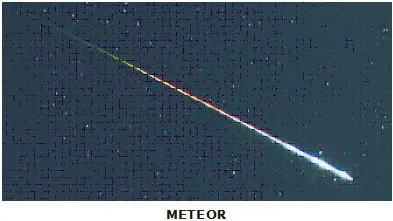
* FACT FILE
The Barringer crater in Arizona, USA was formed when a large meteorite struck the earth.
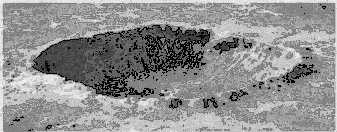
Meteorites are helpful for scientists as they get to study the nature of celestial objects that are the part of the solar system.
SATELLITES
A satellite is a body which is constantly revolving in an orbit around a planet is called a satellites. There are two types of satellites.
(1) NATURAL SATELLITES
A heavenly body which revolves around a planet is called a natural satellite. Ex. – Moon.
The earth has only one natural satellite, the moon. It is held in a fixed orbit around the earth because of earth's gravity. It shines because it reflects the light of the sun.
It completes its revolution around the earth in 27.3 days. Its also takes 27.3 days to complete one rotation about its own axis.
Mercury and Venus have no moon while Jupiter, Saturn and Uranus have 28, 30 and 21 moons respectively.
* FACT FILE
l. The saying once in a blue moon refers to the occurrence of two full moons during one calendar month.
2. A full moon is nine times brighter than a half moon.
(2) ARTIFICIAL SATELLITES
A man made object made to revolve around the earth is called an artificial satellite. Ex.–Aryabhatta.
Nowadays it is very easy to make long distance calls through telephone, forecast weather, locating mineral resources etc. It all became possible because of artificial satellites.
Several countries including India have sent artificial satellites into space. These satellites revolve around the Earth continuously.
The first artificial satellite was sent by USSR (now Russia) on October 4, 1957. It was called Sputnik-I. India sent her first satellite into space on April 19, 1975. It was
called Aryabhatta. Some other Indian satellites are Bhaskara, Rohini, Insat 1-B and Insat 2-B. Today, there are various satellites in space.
An artificial satellite
They are of two types :-
(i) Geostationary or Geosynchronous satellites : A satellite which revolves around the earth in an equitorial plane in the same direction with same time period as
that of earth is called geostationary satellite. It appears stationary with respect to any point on the surface of earth.
(ii) Polar Satellite : A satellite which revolves around the earth in an orbit which passes over its north and south poles is called polar satellite.
* Importance of Artificial Satellites
1. Radio and television transmission.
2. To study and forecast weather.
3. Long distance telephone communication.
4. Locating mineral resources.
5. Gathering information about outer space.
* Weather Monitoring :-
Weather monitoring is to keep a continuous track of various factors on which the weather depends.
The weather is monitored by a fleet of polar and geostationary satellites.
The satellite help meteorologists to make instant weather forecasts including early warnings of weather extremes such as hurricanes cyclones, floods or drought conditions.
It enables the government to take appropriate measure to minimize loss of life and property.
* Remote Sensing :-
The technique of gathering information about the earth through artificial satellites is called remote sensing.
Remote sensing satellite are placed in sun-synchronous orbits.
(Sun-synchronous orbit is a special type of polar orbit in which satellite passes over a latitude at the same local time every day.)
Important applications of remote sensing satellites :-
(1) Ground water and forest surveys.
(2) Detection of potential fishing zones.
(3) Spying for military purposes.
SOLVED EXAMPLES
Ex.1 Mark the following statements as True (T) or False (F):
(a) Pole star is a member of the solar system.
(b) Mercury is the smallest planet of the solar system.
(c) Uranus is the farthest planet in the solar system.
(d) INSAT is an artificial satellite.
(e) There are nine planets in the solar system.
(f) Constellation Orion can be seen only with a telescope.
Sol. (a) False (b) True (c) False
(d) True (e) False (f) False.
Ex.2 In which part of the sky can you find Venus if it is visible as an evening star?
Sol. Western sky.
Ex.3 Name the largest planet of the solar system.
Sol. Jupiter (Brahaspati).
Ex.4 What is a constellation? Name any two constellations.
Sol. Constellations are a group of stars that appear to form some recognizable shape. For examples, Ursa Major and Orion.
Ex.5 Draw sketches to show the relative positions of prominent stars in:
(a) Ursa Major and (b) Orion.
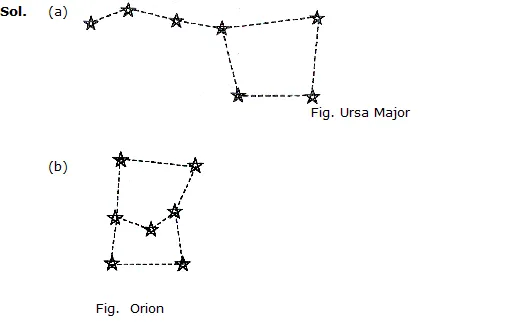

Ex.6 Name two objects other than planets which are members of the solar system.
Sol. Comets, asteroids and meteors.
Ex.7 Explain how you can locate the Pole Star with the help of Ursa Major.
Sol. Pole star can be located with the help of the two stars at the end
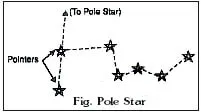
of Ursa Major. Imagine a straight line passing through these stars as shown in Fig.. Extend this imaginary line towards the north direction. (About five times the distance between the two stars).
This line will lead to a star which is not too bright. This is the Pole Star. Verify that the Pole star does not move as all other stars drift from east to west.
Ex.8 Do all the stars in the sky move? Explain.
Sol. No, stars actually do not move but they only appear to move from east to west, as the earth from where we see them, rotates from west to east. However pole star,
which is situated in the direction of the earth's axis. It does not appear to move.
Ex.9 Why is the distance between stars expressed in light years? What do you understand by the statement that a star is eight light years away from the Earth?
Sol. The Sun is nearly 150,000,000 kilometres (150 million km) away from the earth.
The next nearest star to the earth after the Sun is Alpha Centauri. It is at a distance of about 40,000,000,000,000 km from the earth. Some stars are even further away.
It is not convenient to express such distances in kilometres.
Such large distances are expressed in another unit known as light year. One light year is the distance travelled by light in one year.
If we say that a star is eight light years away from earth, it means that the light from that star will reach the earth in eight years.
Ex.10 Why do we classify the sun as a star?
Sol. Sun is classified as a star because it
(i) has its own source of energy.
(ii) is continuously emitting huge amount of heat and light.
(iii) has a life period. It was born 5 billion years ago and is expected to glow for another 5 billion years.
Ex.11 Mention the four independent motions of the earth.
Sol. The earth has the following four independent motions :-
(i) Revolution of the earth in elliptical orbit round the sun.
(ii) Rotation of the earth about its own axis, once in 24 hours.
(iii) Spinning of the earth about its axis.
(iv) Motion of the earth along with the sun and other planets in space.
NCERT QUESTIONS WITH QUESTIONS
Q.1 Which the following is NOT a member of the solar system?
(A) An asteroid (B) A satellite (C) A constellation (D) A comet
Ans. C
A constellation is not a member of the solar system, it is a group of stars that form recognizable shapes.
Q.2 Which of the following is NOT a planet of the solar system?
(A) Sirius (B) Mercury (C) Saturn (D) Earth
Ans. A
Sirius is a star, it is not a planet of the solar system. The star Sirius is the brightest star in the sky. It is commonly known as the Dog Star.
Q.3 Phases of the moon Occur because
(A) we can see only that part of the moon which reflects light towards us.
(B) our distance from the moon keeps changing.
(C) the shadow of the Earth covers only a part of moon's surface.
(D) the thickness of the moon's atmosphere is not constant.
Ans. A
Moon does not produce its own light. Moonlight is reflected sunlight. Depending on the location of the Moon in its orbit around Earth, different parts of the Moon will
reflect sunlight onto Earth. We see only that part of the moon from which the sunlight gets reflected towards us.
Q.4 Fill in the blanks :
(A) The planet which is farthest from the Sun is ___________.
(B) The planet which appears reddish in colour is __________ .
(C) A group of stars that appear to form a pattern in the sky is known as a _______.
(D) A celestial body that revolves around a planet is known as _________.
(E) Shooting stars are actually not ________.
(F) Asteroids are found between the orbits of ______ and ______.
Ans. (A) Neptune (B) Mars (C) Constellation (D) Satellite
(E) Stars (F) Mars; Jupiter
Q.5 Mark the following statements as true or false.
(A) Pole Star is a member of the solar system.
(B) Mercury is the smallest planet of the solar system.
(C) Uranus is the farthest planet in the solar system.
(D) INSAT is an artificial Satellite.
(E) There are nine planets in the solar system.
(F) Constellation Orion can be seen .only with a telescope.
Ans. (A) False
Pole Star is a star and stars are not the member of our solar system.
(B) True
(C) False
Neptune is the farthest planet in the solar system.
(D) True
(E) False
There are eight planets in the solar system.
(F) False
Orion can be seen during winter in the late evenings.
Q.6 Match items in column A with one or more items in column B:
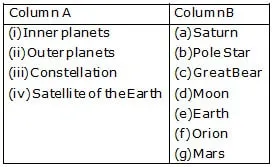
Ans. Column A Column B
(i) Inner planets (g), (e) Mars, Earth
(ii) Outer planets (a) Saturn
(iii) Constellation (c), (f) Great Bear, Orion
(iv) Satellite of the Earth (d) Moon
Q.7 In which part of the sky can you find Venus if it is visible as an evening star?
Ans. Venus can be seen in the western sky after sunset and is called the evening star.
Q.8 Name the largest planet of the solar system.
Ans. The largest planet of the ·solar system is Jupiter.
Q.9 What is a constellation? Name any two constellations.
Ans. The stars which appear to be bunched together in groups and form recognizable shapes and patterns are known as constellations. Examples: Orion constellation and Ursa major constellation.
Q.10 Name two objects other than planets which are members of the solar system.
Ans. Asteroids and meteros.
Q.11 Do all the stars in the sky move? Explain.
Ans. No, all the stars do not move In the sky. The Pole star is located above the axis of rotation of the Earth , In the north direction. Thus, it appears stationary at a
point in the sky, it does not move in the sky. All other stars In the sky appear to move from East to West in the sky.
Q.12 Why is the distance between stars expressed in light years? What do you understand by the statement that a star Is eight light years away from the Earth?
Ans. The distance of the stars from the Earth and the distance between the stars are very large. Thus, it Is convenient to express these distances in bigger units like light years.
If a star Is located eight light years away from the Earth, it means that the light from that star reaches after eight years. In other words, the light of the star which we are seeing
today started from that star eight Years ago.
Q.13 Draw sketches to show the relative positions of prominent stars in
(a) Ursa Major and (b) Orion
Ans. (a) Ursa Major constellation
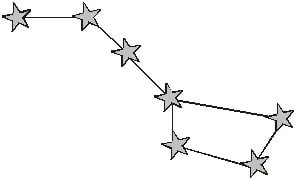
(b) Orion constellation
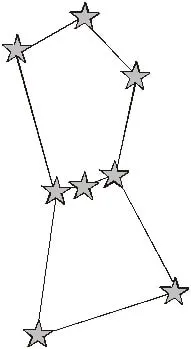
Q.14 The radius of Jupiter Is 11 times the radius of the Earth. Calculate the ratio of the volumes of Jupiter and the Earth. How many Earths can Jupiter accommodate?
Ans. Planets are like spheres. Volume of a sphere is given by,
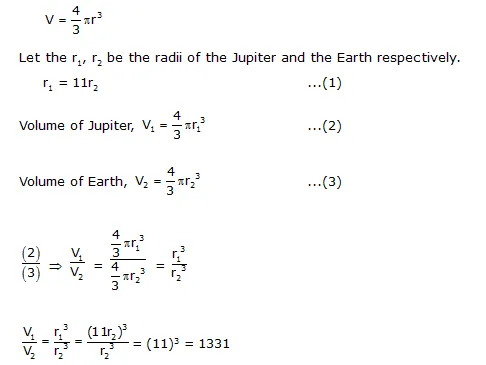
Jupiter can accommodate 1331 number of Earths within it.
Q.15 Boojho made the following sketch (see fig.) of the solar system. Is the sketch correct? If not, correct it.
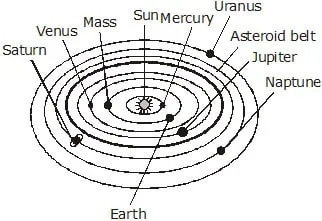
Ans. Boojho's sketch of the solar system is not correct because he has interchanged the positions of Mars and Venus and also the positions of Uranus and Neptune.
Also, he has shown the Asteroid belt in the gap between the orbits of Jupiter and Saturn. This is not correct. The asteroid belt is located between the orbits of Mars and Jupiter.
For correct figure refer theory.
EXERCISE I
Q.1 Name two objects other than planets which are members of the solar system.
Q.2 Explain how you can locate the Pole Star with the help of Ursa Major.
Q.3 Do all the stars in the sky move? Explain.
Q.4 Why is the distance between stars expressed in light years? What do you understand by the statement that a star is eight light years away from the Earth?
Q.5 The radius of Jupiter is 11 times the radius of the Earth. Calculate the ratio of the volumes of Jupiter and the Earth. How many Earths can Jupiter accomodate ?
Q.6 How far is the Sun from the Earth?
Q.7 Name the planet nearest to the Earth.
Q.8 What is a comet?
Q.9 Differentiate between stars and planets.
Q.10 Define a constellation.
Q.11 How many natural satellites do Jupiter and Saturn have?
Q.12 How many kilometre equal 1 light year?
Q.13 Write a short note on the sun and the solar system. Also mention the sun's composition and temperature.
Q.14 Define a constellation and write a short note on two constellations.
Q.15 Give a brief description of all the planets.
Q.16 What are stars? Give examples.
Q.17 Differentiate between natural and artificial satellites. Write the importance of artificial satellites.
Q.18 Why is life not possible on Venus?
Q.19 Why do scientists expect life on the Mars?
Q.20 In which part of the sky can you find Venus if it is visible as an evening star?
Q.21 Name the largest planet of the solar system.
Q.22 What is a constellation? Name any two constellations.
Q.23 Draw sketches to show the relative positions of prominent stars in
(a) Ursa Major and (b) Orion
EXERCISE II
Q.1 Stars are mainly made up of -
(A) oxygen and hydrogen
(B) oxygen and nitrogen
(C) hydrogen and helium
(D) water and helium
Q.2 Orion is a name of a -
(A) Star (B) planet
(C) galaxy (D) constellation
Q.3 Stars appear motionless because –
(A) they move with the same speed as that of the earth
(B) they do not move at all
(C) they are very far away from the earth
(D) their speed is extremely slow
Q.4 Galaxies –
(A) move towards each other
(B) move away from each other
(C) do not move at all
(D) none of these
Q.5 Any heavenly body having light a its own is called a -
(A) nebulae (B) star
(C) comet (D) meteorite
Q.6 Galaxies are usually classified on the basis of their -
(A) mass (B) size
(C) shape (D) none of these
Q.7 Indian name of Milky way galaxy is -
(A) Akash Ganga (B) Dhruv Tara
(C) Saptarishi (D) None of these
Q.8 The vast collection of billion of stars is called a-
(A) universe (B) galaxy
(C) constellation (D) none of these
Q.9 The Milky Way galaxy has a/an -
(A) elliptical shape (B) spiral shape
(C) irregular shape (D) none of these
Q.10 Sun is a -
(A) star (B) planet
(C) galaxy (D) comet
Q.11 Which of the following has a highly elonged elliptical orbit ?
(A) Asteroid (B) Meteor
(C) Comet (D) Meteorite
Q.12 Ceres is -
(A) satellite of the mars
(B) satellite of the jupiter
(C) an asteroid
(D) a meteorite
Q.13 The tail of a comet usually extends to -
(A) 10 kilometers
(B) 2 light years
(C) 800 million kilometers
(D) 1.5 billion kilometers
Q.14 The number of satellite of Venus is -
(A) one (B) two
(C) three (D) zero
Q.15 Which planet is also known as “red planet” ?
(A) Mars (B) Venus
(C) Jupiter (D) Mercury
Q.16 Sources of energy in the sun is -
(A) excitation of atoms
(B) collision of atoms
(C) breaking of heavy nuclei
(D) combination of light nuclei
Q.17 Dark patches present in the photosphere of the sun are called -
(A) sun spots (B) prominences
(C) rings (D) fluorescence
Q.18 The credit for the discovery of rings of the Saturn goes to -
(A) Kepler (B) Galileo
(C) Newton (D) Copernicus
Q.19 Shukra is Venus, as Shani is to -
(A) Saturn (B) Mars
(C) Jupiter (D) Mercury
Q.20 Mercury is closer to the sun than venus. But venus is hotter than mercury because :
(A) Mercury has no atmosphere and venus has a thick atmosphere which can retain the heat
(B) Mercury is mostly made up of sedimentary rocks while venus contains igneous rocks
(C) Mercury being closer to the sun, absorbs the heat of the mercury
(D) All of the above
ANSWER KEY
1. C 2. D 3. C 4. B
5. B 6. C 7. A 8. B
9. B 10. A 11. B 12. C
13. C 14. D 15. A 16. D
17. A 18. B 19. A 20. A
EXERCISE - III
Tick (P) the correct choice among the following :
1. Nucleons correspond to the number of
(A) electrons (B) protons (C) neutrons (D) neutrons and protons
2. The number of neutrons contained in 92U238 is
(A) 92 (B) 146 (C) 238 (D) 330
3. An element X with mass number A and atomic number Z is represented by
(A) X (B) AXZ (C) ZXA (D) ZXA-Z
4. The number of electrons contained in the nucleus of 92U235 is
(A) 92 (B) 143 (C) 235 (D) zero
5. In the following nuclear reaction, what is the element X?
7N14 + 2He4 ® 1H2 + X
(A) 8O16 (B) 7N14 (C) 9F17 (D) 10Ne17
6. The mass of an atom is expressed in
(A) kg (B) g (C) a.m.u. (D) carats
7. The specific charge of an electron is equal to
(A) –1.76 a 1011 C kg–1 (B) 1.76 × 10–11 C kg–1 (C) 1.602 × 10–19 C (D) –1.602 × 10–19 C
8. The mass of an electron is equal to
(A) 9.1 × 10–31 kg (B) 9.1 × 10–30 kg (C) 9.1 × 10–27 kg (D) none of these
9. What is the particle Y in the following nuclear reaction?
4Be9 + 2He4 ® 6C12 + Y
(A) Electron (B) Neutron (C) Proton (D) None of these
10. In the following nuclear reaction, how many alpha particles are given out?
92X234 ® 88Y218
(A) 2 (B) 3 (C) 4 (D) 6
11. In the question above, how many beta particles are given out?
(A) 2 (B) 4 (C) 6 (D) 8
12. An atom bomb is based on the principle of
(A) nuclear fission (B) nuclear fusion (C) the liquid drop model (D) none of these
13. The average amount of energy released during the fission of a uranium atom is about
(A) 100 MeV (B) 200 MeV (C) 300 MeV (D) 10 MeV
14. One electron volt is equal to
(A) 1.602 × 10–19 J (B) 1.602 × 10–19V (C) 1.602 × 10–19 C (D) none of these
15. When a beta particle is given out, the atomic number of the parent atom
(A) increases by unity (B) decreases by unity (C) remains the same (D) is halved
16. The process of fusion is used for constructing a
(A) atom bomb (B) ordinary bomb (C) hydrogen bomb (D) neutron bomb
17. In a nuclear reactor, the moderator is
(A) uranium- 234 (B) uranium-238 (C) cadmium (D) heavy water
18. Which of the following is a good nuclear fuel?
(A) Uranium-236 (B) Neptunium-239 (C) Thorium-236 (D) Plutonium-239
19. Radioactivity was discovered by
(A) Rutherford (B) Becquerel (C) Bohr (D) Madame Curie
20. The radiant energy of the sun results from
(A) nuclear fission (B) nuclear fusion (C) combustion (D) cosmic radiations
21. A magnetic field deflects
(A) alpha particles only (B) beta particles only
(C) alpha and beta particles (D) neither alpha nor beta particles
22. The discovery of neutron was made by
(A) Chadwick (B) Rutherford (C) Becquerel (D) Curie
23. Which of the following has the least penetrating power?
(A) Alpha particles (B) Beta particles
(C) Gamma rays (D) All have the same penetrating power
24. How many electrons are present in Na+?
(A) 11 (B) 12 (C) 10 (D) 1
25. The fraction of the sun's energy received on earth is about
(A) 12% (B) 26% (C) 38% (D) 47%
26. Which of the following source of energy is different from others?
(A) Coal (B) Lignite (C) Petroleum (D) Plants
27. Which of the following source of energy is different from others?
(A) Bitumen (B) Anthracite (C) Coke (D) Gobar gas
28. Choose the only renewable source of energy
(A) Coal (B) Uranium (C) Natural gas (D) Geothermal power
29. The mass of the sun is about
(A) 1029 tonnes (B) 1027 tonnes (C) 1025 tonnes (D) 1023 tonnes
30. The temperature of the sun's core is about
(A) 103 °C (B) 104 °C (C) 105 °C (D) 106 °C
31. The surface temperature of the sun is about
(A) 106°C (B) 5800°C (C) 104°C (D) 1000°C
32. Earth's upper atmosphere receives about _____ kJ of sun's energy per second.
(A) 9.46 (B) 4.37 (C) 8.25 (D) 1.36
33. The fuel used in nuclear reactors is
(A) U-235 (B) U-236 (C) U-234 (D) U-238
34. The nuclear fuel in the sun is
(A) helium (B) uranium (C) hydrogen (D) alpha particles
35. Most of the propellants used in rockets are
(A) solids (B) liquids (C) gases (D) all the above
36. Which of the following cannot be seen by the eye?
(A) Ultraviolet rays (B) Gamma rays (C) Infra red rays (D) All the above
37. Light year is the unit of
(A) energy (B) distance (C) time (D) mass
38. A wavelength range of 4 × 10–7 m to 7 × 10–7 m is seen in
(A) ultraviolet rays (B) infrared rays (C) visible light (D) X-rays
39. The process of splitting up of white light into seven constituent colours is called
(A) dispersion (B) photosynthesis (C) spectrum (D) refraction
40. Which of the following colour has the maximum wavelength?
(A) Red (B) Yellow (C) Violet (D) Green
41. The longest and shortest wavelengths (in microns) for red and violet colours are respectively given by
(A) 0.4, 0.7 (B) 0.3, 0.6 (C) 0.7,0.9 (D) none of these
42. What is the percentage of 92U235 in 92U238 ?
(A) 0.2% (B) 0.7% (C) 98% (D) 100%
43. Which of the following isotopes of uranium is unstable?
(A) U-234 (B) U-235 (C) U-238 (D) all the above
44. In India, uranium is found in
(A) U.P. (B) M.P. (C) Bihar (D) Orissa
45. When was India's first critical nuclear reaction carried out?
(A) December, 1941 (B) December, 1964 (C) January, 1950 (D) March, 1971
46. What percentage of energy requirement of India is met by nuclear power stations?
(A) 3% (B) 5% (C) 10% (D) 20%
47. The process by which the percentage of U-235 in U-238 is increased, is called
(A) fission (B) fusion (C) chain reaction (D) enrichment
48. The enrichment of uranium is carried out at
(A) Hyderabad (B) Chennai (C) Kolkata (D) Mount Everest
49. Choose the source of energy different from others:
(A) Hydropower (B) Ocean waves (C) Geothermal power (D) Natural gas
50. One of the most important liquid propellants used in rockets is
(A) liquid hydrogen (B) liquid ammonia (C) liquid fluorine (D) hydrogen peroxide
51. The nuclear fuel in the sun is
(A) carbon (B) hydrogen (C) helium (D) nitrogen
52. The sun's energy powers the
(A) flow of wind (B) flow of water on earth
(C) process of photosynthesis (D) all the above
53. Energy per m2 of the earth's upper atmosphere receives ...................... of sun's energy per second.
(A) 1.36J (B) 2.36J (C) 1.36 kJ (D) 1.36 cal
54. Which of the following has the shortest wavelengths?
(A) Ultra-violet rays (B) Visible light
(C) Infrared rays (D) Nothing can be decided
55. About one-third of the energy that we receive from the sun consists of
(A) infra-red rays (B) visible light (C) ultra-violet rays (D) all the above
56. Which of the following component of sunlight facilitates drying of clothes?
(A) Infra-red rays (B) Visible light (C) Ultra-violet rays (D) All the above
57. Energy that hot object emits is
(A) X-rays (B) infra-red rays (C) visible light (D) none of these
58. Infra-red rays are emitted by all
(A) objects (B) cold objects (C) hot objects (D) none of these
59. Which of the following types of radiations is used in heating of a solar cooker?
(A) Visible light (B) Infrared rays (C) Ultraviolet rays (D) None of these
60. Which type of radiation is emitted by a kettle containing boiling water?
(A) Infrared rays (B) Visible light (C) Ultraviolet rays (D) None of these
61. Which of the following is a star?
(A) Sun (B) Mercury (C) Pluto (D) Venus
62. The planet having the largest number of satellites amongst the following is
(A) Jupiter (B) Saturn (C) Uranus (D) Mars
63. Which of the following planets has the least number of satellites?
(A) Earth (B) Neptune (C) Uranus (D) Mars
64. Which of the following is a natural satellite of our planet?
(A) Moon (B) Sun (C) Jupiter (D) Saturn
65. Which of the following is the smallest planet?
(A) Jupiter (B) Venus (C) Mercury (D) Pluto
66. Which of the following is the biggest planet?
(A) Jupiter (B) Venus (C) Mercury (D) Pluto
67. Any heavenly body having light of its own is called a
(A) nebulae (B) star (C) comet (D) meteorite
68. Any heavenly body which revolves round a planet is called a
(A) comet (B) star (C) satellite (D) nebulae
69. How much time does light from the sun take to reach the surface of the earth?
(A) 400 s (B) 500 s (C) 450 s (D) 555 s
70. Velocity of light is
(A) 3 × 104 km/s (B) 3 × 106 km/s (C) 3 × 105 km/s (D) 3 × 103 km/s
71. The ratio of earth's gravity to sun's gravity is
(A) 6 (B) 1/6 (C) 28 (D) 1/28
72. The planet nearest to the sun is
(A) Mercury (B) Earth (C) Venus (D) Pluto
73. The planet farthest from the sun is
(A) Mercury (B) Venus (C) Pluto (D) Earth
74. Shooting star is another name for
(A) comet (B) meteor (C) solar flare (D) nebulae
75. The part of a meteor which reaches the earth's surface is called a
(A) comet (B) meteorite (C) shooting star (D) nebulae
76. The tail of a comet always points
(A) towards the sun (B) away from the sun (C) towards north-east (D) towards south-west
77. The star nearest to the sun is
(A) Sirius (B) Proxima centauri (C) Alpha centauri (D) Cygni
78. The colour of a star depends upon its
(A) density
(B) distance from the sun (C) surface temperature (D) radius
79. Which of the following does not represent a cluster of stars?
(A) Rigel (B) Aquarius (C) Capricorn (D) Aries
80. How many constellations comprise the signs of the zodiac?
(A) 6 (B) 9 (C) 11 (D) 12
81. The earth spins about its axis from
(A) west to east (B) east to west (C) north to south (D) south to north
82. A family of stars is called a
(A) galaxy (B) solar system (C) universe (D) whirling havens
83. Great Bear is commonly known as
(A) Saptarshi (B) Dhruv tara (C) Pole star (D) Orion
84. Dark patches present in the photosphere of the sun are called
(A) sun spots (B) prominences (C) rings (D) fluorescence
85. Which of the following belongs to the class of inferior planets?
(A) Mercury (B) Venus (C) Pluto (D) Saturn
86. Which of the following belongs to the class of superior planets?
(A) Venus (B) Neptune (C) Uranus (D) Mars
87. The credit for the discovery of rings of the Saturn goes to
(A) Kepler (B) Galileo (C) Newton (D) Copernicus
88. Titan is the largest moon or satellite of
(A) Mars (B) Venus (C) Jupiter (D) Saturn
89. The mean distance between the earth and the sun is referred to as one
(A) light year (B) fermi (C) astronomical unit (D) angstrom
90. The ratio of the gravitational pull of the moon to that of the Earth is
(A) 6 (B) 4 (C) 1/6 (D) 1/4
91. The difference between the equatorial diameter and polar diameter of the Earth is about
(A) 43 km (B) 82 km (C) 56 km (D) 101 km
92. Day and night are caused by
(A) rotation of the Earth (B) revolution of the Earth
(C) both rotation and revolution of the Earth (D) neither rotation nor revolution of the Earth
93. Halley's comet was first seen by
(A) Galileo (B) Copernicus (C) Halley (D) Newton
94. Reflection of the sun's light from the upper layers of the earth's atmosphere causes
(A) day and night (B) tides (C) eclipses (D) twilight
95. The globe of Saturn can contain about
(A) 150 Earths (B) 472 Earths (C) 355 Earths (D) 763 Earths
96. The vast surrounding space is called
(A) galaxy (B) universe (C) planet (D) none of these
97. One light year is equal to
(A) 3.26 parsec (B) 3.26 km (C) 3.26 A.D. (D) parsec
98. Which of the following is different from others?
(A) Light year (B) Parsec (C) Astronomical unit (D) Micron
99. Which of the following is the largest astronomical unit?
(A) Light year (B) Parsec (C) km (D) Astronomical unit
100. Which of the following is the smallest unit of distance?
(A) Light year (B) Parsec (C) Astronomical unit (D) Km
